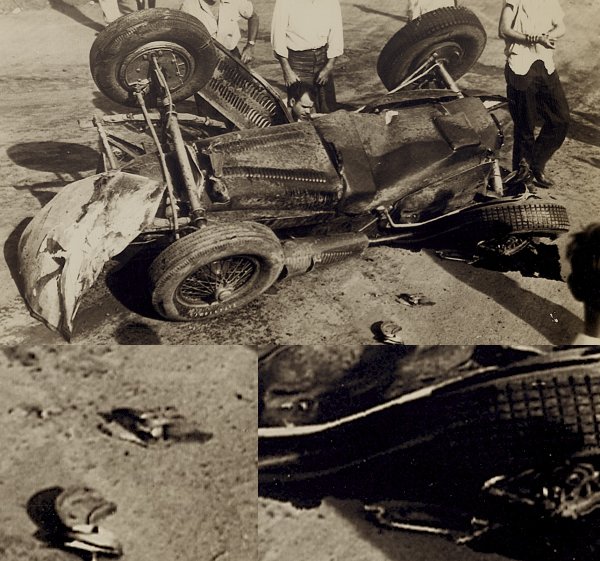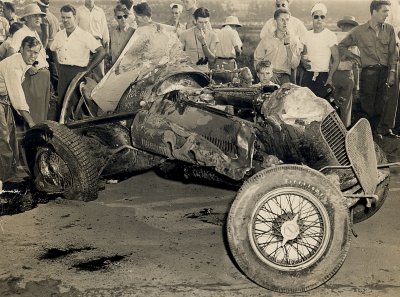Interesting Observations

Robson's car sits upside down on Lakewood's backstretch. In examining this photos, T.C. Chambers noticed what he thought might be Robson's gloves (seen up close in the lower left) and what may be a flask under the right rear tire (seen up close in the lower right). The hood from Barringer's racer can be seen leaned against the front of Robson's car. Photo courtesy Eddie Samples
In the course of interviewing and revisiting the accident with T.C. Chambers, there were some interesting things that we came across in the photos of the accident scene.
For example, in the photo of Robson’s car laying overturned on the backstretch, Chambers noticed what appears to be a pair of gloves lying next to the car. It’s possible that, for whatever reason, Robson removed the gloves during the course of the race, and dropped them into the floorboard or into his lap. When the car became airborne, they would have fallen out.
Chambers also noticed what appears to be a flask lying under the right rear tire in the same photo. He surmised that Robson could have sipped water from it on that hot, dusty day.
This same photo also called something to my attention several weeks ago. Looking at the front of the wreck, you can clearly see the mangled remains of the hood from Barringer’s car, with the unique 7 visible. At first, I thought this might indicate that Robson’s car actually climbed up on top of Barringer’s. However, Chambers recalls someone picking up the hood and leaning it against the front of the Noc-Out Special.
Which brings us to another interesting point. While Ted Horn was credited with the victory at the scene, AAA officials later stripped him of the win after he admitted he had struck “something” while passing through and past the accident scene. Under the rules, if you were involved in an accident, you were disqualified. Officials ruled Horn’s striking of something in the accident constituted him being involved in the crash, and awarded the victory to George Conner. Could that “something” that Horn struck have been that hood?

Robson's car after being uprighted. The man standing behind the car, to the right of the AAA official in the helmet, is Ted Horn, who was originally named as the winner of the event. Photo courtesy Eddie Samples
Incidentally, Chambers recalls Conner making another lap around after Horn stopped on the track to try to flag down other competitors to warn them of the accident. It could be that Conner actually did beat Horn in the event on laps, but according to reports, the AAA ruled on the accident situation.
One other interesting observation before we leave Robson’s car. Looking at the back of the Noc-Out Special, the back end, including the gas tank, is gone from the car. Was it sheered off as a result of the car flipping, or from one of the two impacts he had that triggered the accident?
Which brings us to another interesting observation. At this portion of the race, the cars were running with very little fuel left in the gas tanks. If this accident had occurred earlier in the event, the backstretch likely would have been turned into an inferno, leaving more drivers and possibly spectators dead. This was the era before fuel cells when fire was the number one danger at a racetrack.
There were some other interesting things we noticed in the photo of Robson’s car after it had been righted. Standing behind the mangled vehicle is Ted Horn, along with a AAA official. It appears that Horn, who was always meticulous in his appearance, cleaned up in the pits before returning to the accident scene. It’s not the state you would expect to see a man who had just raced almost 100 miles in blinding dust to look like, which is probably why he was overlooked in the past.
Chambers also noticed the grey colored dirt on the track in the lower left hand corner of the picture. He believed it was blood, which photographs grey in a black and white photo.
